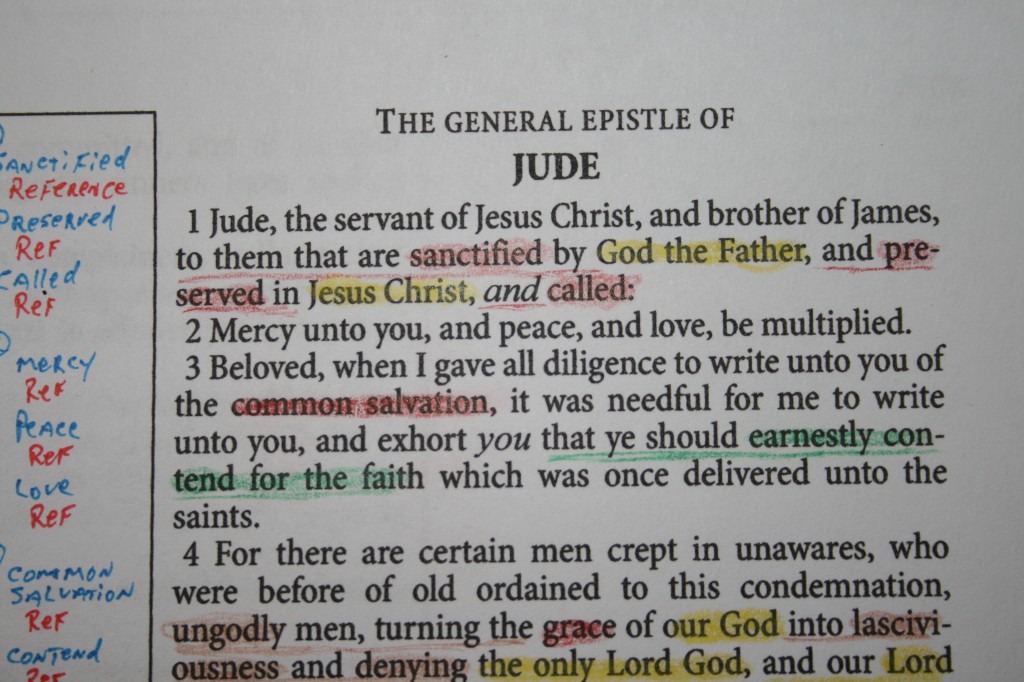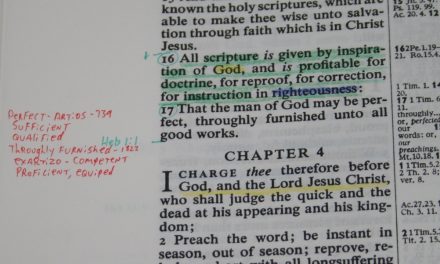One of the most valuable active reading methods is highlighting. Highlighting is a good way to identify the main points of a text. Some of the most useful things to highlight include words, phrases, and sentences. This helps to understand the thought of the writer. It also helps in determining meaning, and is a great help in memorization. For me, highlighting is one of the best memorization tools.
I use highlighting differently than I use color-coding. For color-coding, I color topics. You can also use color-coding for memory verses, verses that speak to you, and many others. In highlighting, the reader will highlight according to importance and for future reference, but will also use highlighting to help determine key points in the text.
Highlighting methods include underlining, color highlighting with pencil or markers, and symbols and letters. If you color-code your Bible (like I do), it might be best to use a separate Bible for highlighting (depending on your methods). Also, be careful not to highlight everything. Highlighting is meant to allow something to stand out from everything else. If everything is highlighted, you end up where you started.
Here are some ideas of things to highlight:
Key passages. Key passages are passages that you learn from and can apply to your life. They can also be passages that speak to you, or key topics that you study. An example might be passages that talk about prayer. You can write a reference in the margin for the next passage on this topic. Highlighting key passages can also include topical color-coding (a method I use extensively).
Keywords and phrases. Over the years I’ve developed my marking methods. I use to highlight the complete verse a certain color according to its topic. I then moved to highlighting the phrase within the verse according to its topic. Now I highlight differently. I underline the phrase within the verse and highlight the key words. For example, in John 3:5 I would underline the phrase “Except a man be born of water and of the Spirit, he cannot enter into the kingdom of God” in red because red is my Salvation color. Next I would highlight the key words “born”, “water”, and “Spirit” in red. Another way to do this would be to highlight the phrase “born of water and of the Spirit” in red. There is no real right or wrong way to do this. It’s completely a personal preference.
Expressions of emphasis. Expressions of emphasis can summarize the main point of the passage or text. You can choose a specific color or method of marking the main point. This not only helps you discover the main point, it also helps when scanning the page later to quickly determine a summary of each passage or page.
Repeating words and phrases. The repetition of words shows emphasis of thought and importance. Highlighting these words can show importance in a topic or train of thought. One example, a major repeating word in the Old Testament is Sanctuary. The word Sanctuary is repeated not just in one passage, chapter, or book, but throughout the entire Old Testament. By recognizing these repeating words you can get the bigger picture. Now, these repeating words must be kept in proper context, but the repetition of the word shows the importance of the point even through other topics. A look at Hebrews chapter 11 shows the importance of Faith. It tracks Faith through the Old Testament and shows the power Faith can have in your life. Outlining repeating words (such as in your margin or notebook) can show the writer’s thoughts on a topic.
Connecting words and phrases. Connecting words can help the reader follow the train of thought and show how points relate to each other. This can show cause and effect, and contrasting ideas.
Contrasting words and phrases. Many passages use contrasting words and phrases to emphasize a point. For example, many passages contrast sin and holiness. We could color sin one color and holiness another. This would give us a ‘do this not that’ application to our lives. This can bring out the importance of living for God.
Relationships. Relationships can include ideas, people, cause and effect, places, events, and on and on. Anything that has a relationship to something else that seems important to you.
There can be many other ways that highlighting can help in active reading. This is not an exhaustive list. It’s only a starting point. You might only need one or two of these methods or styles, or you might want to use this as a guideline to develop your own.
I recommend Pigma Micron markers and Prismacolor pencils for marking, note-taking, and highlighting in your Bible. They have much less tendency to bleed through the page and make indentions in the paper.
Bible study is not easy. It requires hard work and persistence. The Scriptures are like a treasure that is hidden in a field. If we truly seek to know the truth of God’s Word, and to know what God is speaking to us, we will dig for the treasure. Through digging, we grow in truth and knowledge of the ways of God. Only then can we truly apply God’s Word to our lives.
Application is the most important part of reading the Bible. All of these highlighting techniques can help see the point of the text that we should apply to our lives.












Is that a LCBP notetakers?
Hi Kyle. It is the Notetakers. It’s the sample PDF from their site. This sample was the older Notetakers with a different font.
Dear Randy:
I know that highlighting and writing notes as an aid to learning is popular and sometimes effective. I have however repented of these actions in favor of separate notebooks. The reason that I have changed my behavior is that I used highlighting and marginal notes while a student at USF (University of San Francisco) so many years ago because my interest, were in History, Geography, Philosophy, and Theology, there were lots of great books on my reading list that were marked up. After a few years I have often gone back and while re-reading the text and my notes, have wondered why I marked and wrote what I did. Often with maturity and with better judgement I wish I had written or marked differently, or not at all as I have developed different opinions and viewpoints on how the text interacted with my knowledge. I have taken to keeping separate notebooks for these reasons. Notebooks can be organized in various ways and have lots more room for thoughts, cross references, citations page numbers etc. or one can keep notebooks by subject or time sequence or by characters or…………… I’m sure you get the idea, One couldn’t carry a bible large enough to contain the notations made in notebooks. I have seen bibles so marked up that it is difficult to read the text, the notes also become prejudicial to later learning and formation of divergent ideas.
If anyone chooses to mark their bibles or other reading material, and you all think it helps, go ahead, most folks do make marginal notes and highlight their reading. Myself, I am still wondering why I made the notes and highlights that I did, and wishing that I hadn’t, the notebooks for me make more sense, and do not have me wishing I had not marked up a well loved bible.
Don Denison
Hi Don. I like using notebooks too. I used to mark every Bible, but now I just mark in wide margin editions and leave all of my regular Bibles clean. I like to keep at least one Bible for marking, but I also like to keep my other Bibles unmarked. I don’t really like my own handwriting and it’s hard to read anything I write, even in wide margins. Like you, I marked all of my study material. Now I don’t mark in my books. Instead, I use my PC. If a person wants to write in their Bibles, I recommend having one just for that purpose. I also recommend having at least one that you don’t write in.
Dear Randy:
It sounds like good sense to me. Time has a way of changing how one understands text so sacrificing one bible for mark up makes some kind of sense. There is a church member here who has more notes than text, well it seems like it, I looked at the bible and wondered what was bible and what was notes and noticed how the notes were crossed out and redone after time had past. Note books make the best sense for me for serious study. With a clean copy of the bible one is not prejudiced by notes taken earlier, another advantage. I guess the bottom line is what works for the individual reader.
Yours in Christ
Don Denison
Thank you for this article. I’m not sure why I didn’t think of only writing in just one bible before. I love having a clean text to read, but I’ve fallen into the bad habit of writing/highlighting all of my bibles.
Hi Kenny. I used to write in every Bible I got my hands on. Then I started getting ideas of different ways to mark, but all of my Bibles were already marked. This happened one too many times :0) I ended up getting a quality Bible and I couldn’t decide on how to mark it. I got used to seeing its clean text decided to leave it that way. Now I mostly mark in wide margin editions and I’m more careful about which regular Bible I mark.
Bible does NOT deserve to be vandalized, use separate notebook, instead.